The movie Big Miracle and what I witnessed in real life, part 15: epilogue: Malik finds two carcasses upon a beach; gray whale flukes; even as he lived, so departed Malik
 Sunday, February 26, 2012 at 8:41AM
Sunday, February 26, 2012 at 8:41AM The following summer, a number of gray whale carcasses lay on the beaches north and south of Barrow. About twenty miles to the southwest, Malik found two together and believed these might be Crossbeak and Bonnet. He reported his find, then returned to the site with NSB Wildlife biologists Craig George and Geoff Carroll, Marie Carroll and the Carroll's one-year old son, Quinn. I came along. One carcass lay on the beach, completely out of the water. The tail of the second lay on the beach, its body extended at an angle outward into the water. The biologists took measurements and studied the condition of the whales. The one lying on the beach measured twenty-six feet in length, seven inches off of the in-water length estimate they had made for Bonnet. Malik knelt at its head. A fond smile crossed his face as he gave the dead whale a pat.
After comparing the skin damage and noting the distance the carcass had been pushed up the beach, the biologists concluded this was not Bonnet, but rather a whale that had likely died the year before the rescue. The other dead whale measured more than forty feet, compared to the thirty-foot estimate the biologists had made for Crossbeak. Here Craig George measures the bigger whale.
Many whale watchers venture each winter to Mexico's Sea of Cortez to observe gray whales. Following the rescue, the call went out for people to look for Crossbeak and Bonnet. The wounds they had suffered in Barrow would have turned to scars that should have been easily identifiable to those who knew what to look for. No sightings were ever reported.
Some people have told me that the observations in the Sea of Cortez are thorough enough that if the whales had shown up there, they would likely have been spotted and identified.
Still, the ocean is a big place and as big as whale is, by comparison it is a small thing. So, when it comes to the two gray whales, people are free to believe whatever they want: the whales swam free and lived; the whales died, if not at Barrow, somewhere enroute.
Whatever happened, it does not seem that there will ever be any way to verify it.
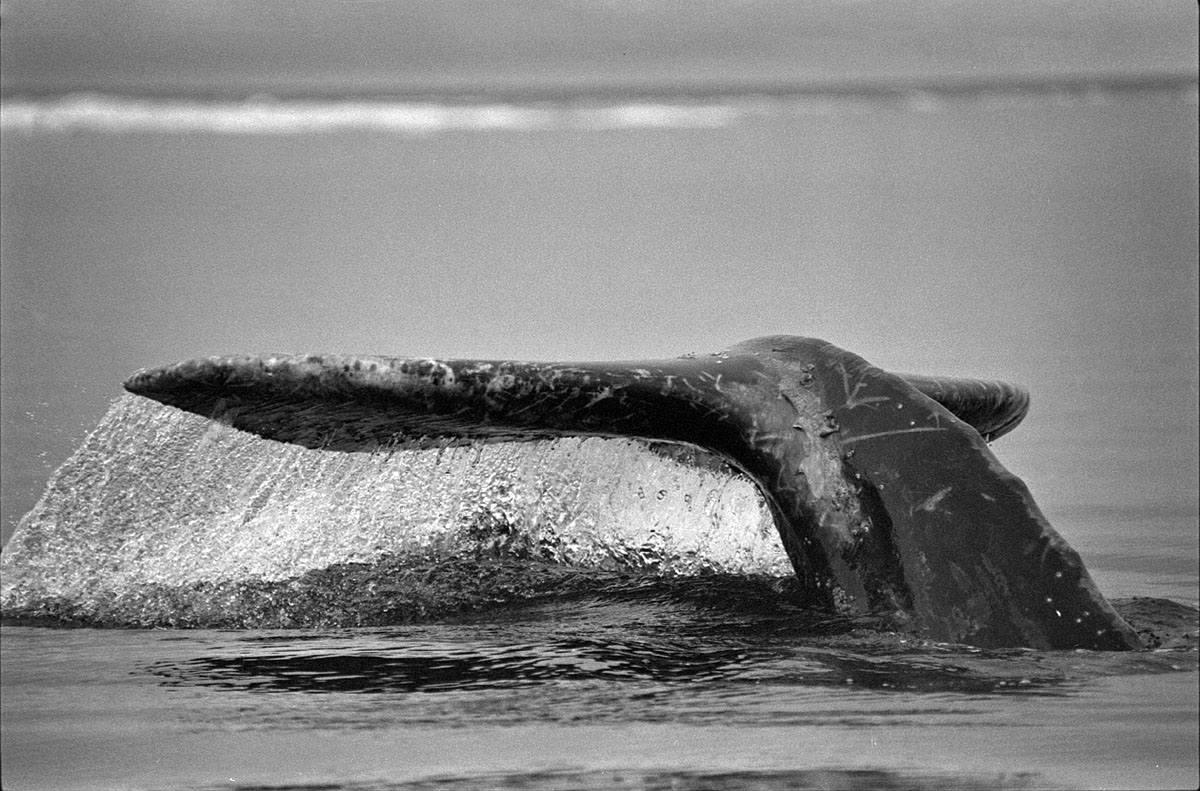
At the moment, I have no further funding to continue Uiñiq. It feels to me like my days making that magazine are over. So far, the magazine has had three incarnations, so I can't say for certain. I have thought this before and then, sooner or later, I have been asked to do an issue, or a few issues. Maybe at some, someone with the authority to fund it will want me to make Uiñiq again and if that should happen, I think it almost a certainty that I would - provided that the opportunity came with the necessary amount of freedom.
Uiñiq is one of the great loves of my life - not because of the paper and ink that it is made of, but because it has given me the opportunity to become somewhat familiar with a climatically harsh but fantastic piece of the globe, and to walk and boat and snowmachine among rugged, smart, and good people who have allowed me to document their way of life and who I have been fortunate to have been befriended and even adopted by.
The first incarnation began at the end of 1985 and lasted through the third quarter of 1996, when circumstance forced me to walk away from Uiñiq, and not without tears.
My love and ties to Barrow and all the villages of the Arctic Slope remained strong and the following summer, 1997, with a little help from the school district, I found my way back for a short visit. During that visit, Roy Ahmoagak invited me to go on an ugruk (bearded seal) hunt with him and his cousin, Richard Glenn.
As we motored through the July icebergs of the Chukchi Sea, a gray whale suddenly lifted its flukes up in front of us...
...
... please note the scars on the tail... many of these were likely made by the teeth of killer whales, perhaps some by the claws and teeth of polar bears, others by sharks - all members of the gantlet that Crossbeak and Bonnet would have had to swim through...
...
In early October of 2002, I received a phone call from Roy Ahmaogak, who spoke in a subdued and hurt voice. He informed me that a bowhead had been taken near Barrow. As always, the hunters attached a line to the whale and several boats hooked up to tow it back to shore. Somehow, the boat that Malik was in got in a tangle and flipped upside down. The others in the boat escaped, but Malik got trapped beneath. Before his fellow whalers, Roy included among them, could right the boat and save him, Malik drowned.
He died as he lived - whale hunting. Shortly afterward, I was contacted by the Arctic Slope Regional Corporation and asked to make a large, framed, print of this photo for display at the funeral. The photo now hangs in the Iñupiat Heritage Center - Barrow's museum. I badly wanted to go to the funeral, but it came at one of those moments of famine in the feast-and-famine cycle that I live through as a freelance photographer. I did not have plane fare. The fact that I missed the funeral is one of my great regrets. Normally, a body will be transported from the funeral site to the graveyard in the bed of a pickup, but little Malik - the Little Big Man, Ralph Ahkivgak, was so beloved by the people of Barrow, whom he had served, taught and helped to feed throughout his life, they spontaneously hoisted his coffin onto their shoulders and carried him to the cemetery, where he was laid to rest in the permafrost.
Malik - the man who could watch a whale dive, then direct the crew to a certain spot and that is where the whale would rise. Malik, who befriended three gray whales stuck in the ice off Barrow and became instrumental in the effort to rescue them. Craig George said this about Malik's role in the rescue:
"Malik seemed to have a rapport with the whales. I can tell you one thing I learned. We had gray whale biologists here, all kinds of people, but Malik was the one to listen to.”
"He was looked up to as a man with great knowledge and he taught a lot of young guys," said Roy Ahmaogak. "He meant a lot to Barrow and a lot more to me, because I knew we were in good hands when we were with Malik. We didn't need any gps or technology, because he knew the ocean very well."
One day in the summer after the rescue, I stopped by Malik's tiny house in Browerville for a visit. He told me that when I had seen and heard him talking to the gray whales during the rescue, what I hadn't heard was the gray whales - but he did hear them. Just as he spoke to them, they spoke to him. “‘Malik, we’re scared,’ they tell me. ‘Malik, we’re scared. Help us, Malik. Help us.’ I tell them, ‘Don’t worry. It’s going to be all right. We’ll get you to the lead. You’ll be safe there.’”
And in the eyes of the late, great, whale hunter and whale rescuer, I saw tears.
Complete series index:
Part 2: Roy finds the whales; Malik
Part 5: To rescue or euthanize
Part 6: Governor Cowper, ice punch, chainsaw holes
Part 7: Malik provides caribou for dinner
Part 8: CNN learns home is sacred place
Part 9: World's largest jet; Screw Tractor
Part 11: Portrait: Billy Adams and Malik
Part 12: Onboard Soviet icebreakers


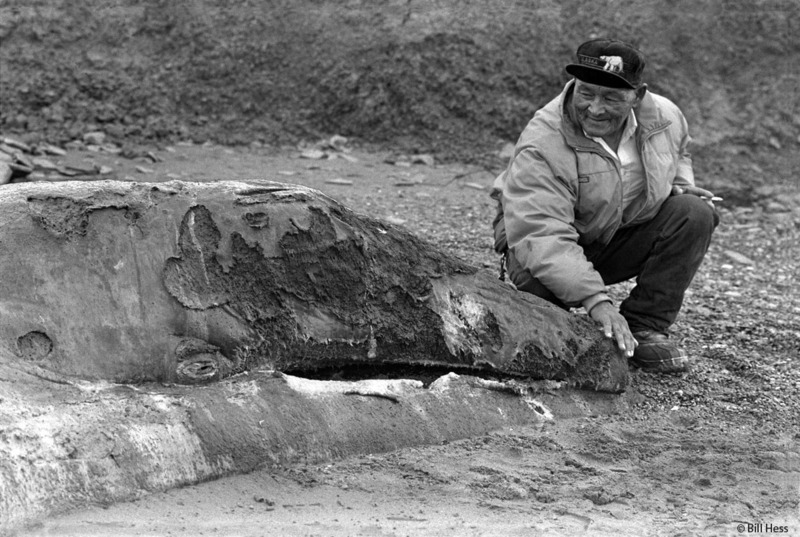
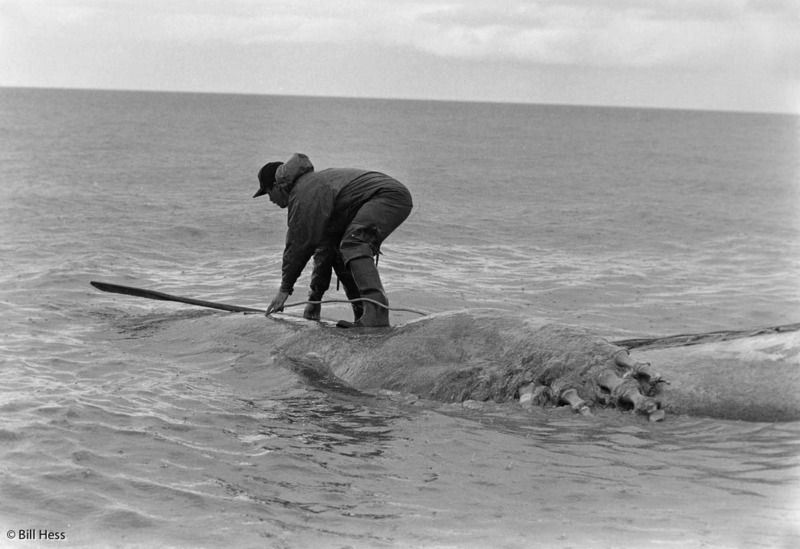
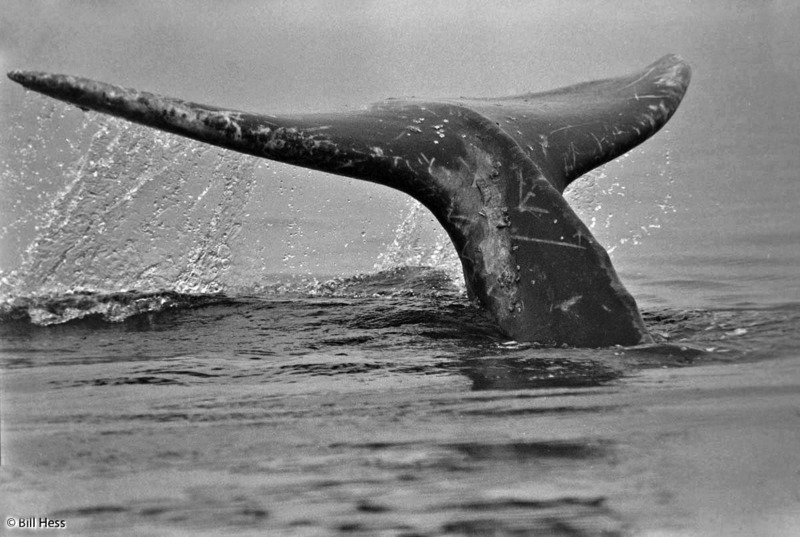
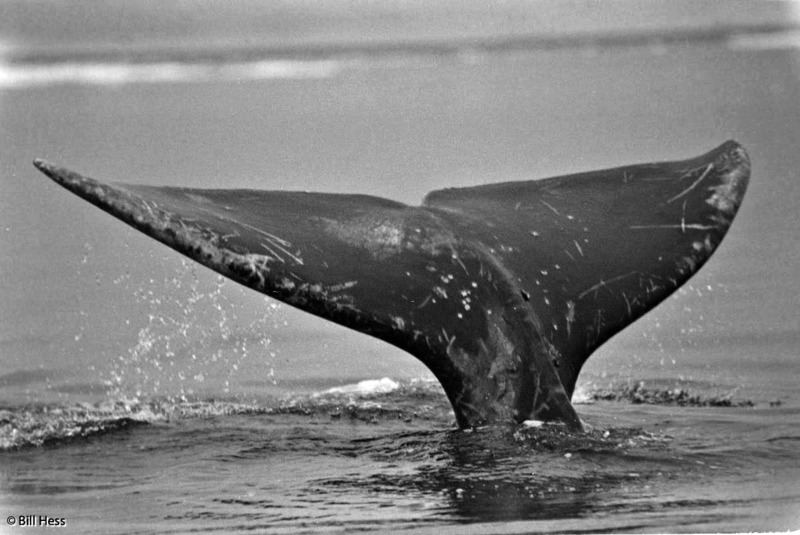
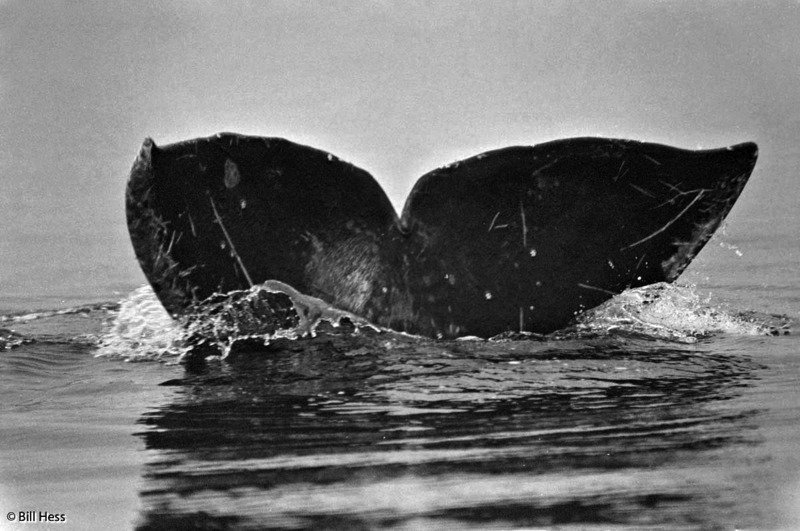
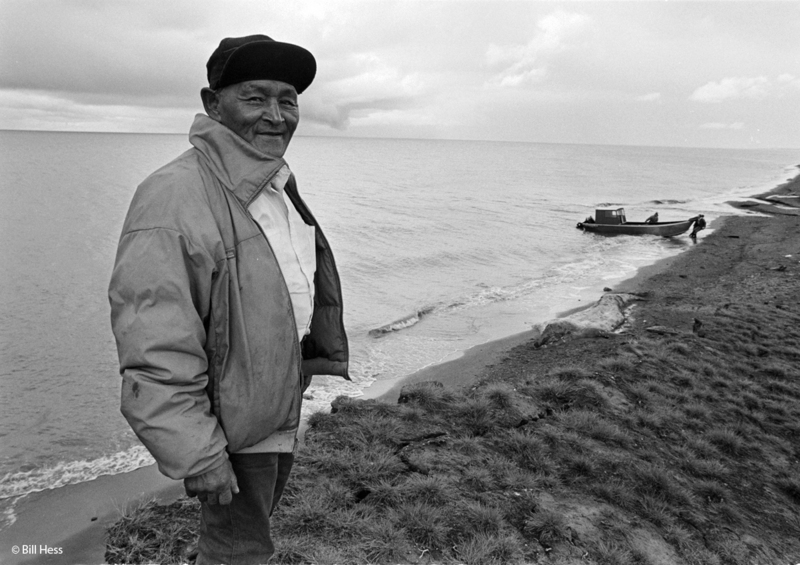
Reader Comments (20)
We love you Bill. Thank you for everything you've shown us, given us, and thank you for showing the world what needs to be seen. You are an amazing individual, and I hope we continue to meet along our journeys, you truly are a great man. Hopes and prayers for your continued struggle to keep Uiniq up and running, we love what you do, and so do others. Something will come up. Thank you brother.
Bill.. I just do not have the time to read all of it.. but I absolutely want to come back to this whole series.. thanks for taking the time to do this huge task of showing us the photographs, even without scanner, amazing stuff..
Thank you, Bill. This series is a book and it is a privilege to read it. Thank you so much.
Thank you for this series. I would love to see someone, say PBS, do a documentary on the rescue effort from your perspective and using your photographs.
i'm with Linda, i would love to see a documentary...i will probably never watch the movie and i'm sad about Malik and even the whales..i think the whalers had the right instincts and should have been listen too.
Bill, this series has really been amazing, moving, eye-opening... I second the book idea!
I read all 15.. slowly.. I read some of them over again. Beautiful Bill. Just amazing. I feel like that connection that you always give us to the places we have never seen, but wish to because of your pictures has go there, has just been brought to a whole new level.
Malik is my new hero. What an amazing man.
I agree with all of the people who have commented. All of your writing moves me- but this story is the one that got into my heart. I want to buy your book. I think you should have a button where we could purchase these amazing stories and photographs. I also would like to see a documentary of the story you have told here.
How fitting that a black and white film recounting another era should be awarded the Academy Award just as the epilogue to your black and white photo essay has been posted. There is a certain autheniticity and mystique that both works share and preserve. May your travels on to India be as rewarding as your experiences to date have proved to be.
Thanks, everybody. I will look into this book idea. PBS would be okay, in addition. I'm too wiped out to write anymore than this right now. Off to India soon.
http://northwestern.rivals.com/showmsg.asp?fid=57&tid=169803163&mid=169803163&sid=901&style=2
Link to thread regarding making of the movie photos I took and references to this blog as to the real events
I sat very quietly, barely moving, through this whole series of posts in an old habit from childhood. I used to be afraid the magic would flee if I broke the spell with a word or a movement.
I guess I still worry about it even though what you have done here is so rock solid I can't believe anything could rattle its bones much.
Thank you Bill for all the days and days you were there to witness this story and for sharing it so fully.
Real life really is magic.
safe travels to India!
One-of-a-kind will always keep its place in people's minds, and that's a lot more than a fleeting stop in people's magazine...
Thanks for a one-of-a-kind experience, Bill
Thank you for your story Bill - I was interested in the original story of the whales after renting the film, I googled and these pages came up. After reading your story and viewing your beautiful pictures, I am grateful that you took the time to put it up here, as another poster said previously, real life really is magic. And so are your photos. I am in awe of you being able to be in such an extreme climate, under extreme conditions (all the politics involved as well as how dangerous physically that area of the world is) and still you took such amazing and beautiful pictures that share the story even all these years later. Thank you thank you thank you.
Thank you for this, Bill. You have a real gift with pictures that is well accompanied by your gift with words. You are an extraordinary storyteller, and I will forever cherish what I read her. Thank you from the bottom of my heart.
I cannot add more to what others have posted, but Thank You. I just viewed the movie and was looking for more information on this event. Real life insight plays so much better than movies. Hope you find all of your wonderful photos.
An incredible story; magnificent and moving photographs. Thank you so very much for telling your story.
I've watched the movie many times as I've always been enamored of whales. I finally went to Wikipedia to look up Barrow and through links came upon your log here. For those of us who have read this and enjoyed your photographs, you are our Malik... Thank you so much
thank you sir for taking the time to write your essay. moved and thrilled by your beautiful accounts of real life experiences with real life humans and animals. please continue to share as this world needs real people; now more than ever. with love and respect from australia.
I can't thank you enough for these shared memories of events twenty odd years ago, and a long way from here in the UK.
I have just watched "Big Miracle" with my eight year old son, and was left feeling dissatisfied, as I so often am by fiction "based on a real story", my son was also left with lots of questions which I couldn't answer, so we came online to search for some more accurate accounts. We couldn't have found a better one, and in the process, we have also learnt so much about the culture of the Iñupiat and of the time and place of these events which we would never, otherwise, have ever known.
My son was particularly interested in your account of the Russian icebreakers, his maternal Grandfather served on a Soviet Ice Breaker in his youth, although his service ended before the 1980s, he would have been familiar with the world you encountered below decks.
I was as moved by your tale of Malik the harpooner and whale rescuer as I was by the tale of the stranded whales. In many Middle Eastern languages the title Malik means "Leader" or "Chief", it's a term of respect traditionally granted only to those of great charisma and wisdom, how apt a name for this gentleman of the Arctic.